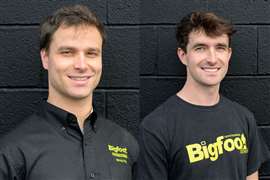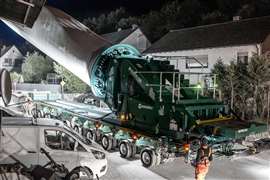How to increase safety on site with new technology
18 September 2023
New technology launched to the crane market is improving safety on site. Niamh Marriott reports.
New technology launched to the industry aims to improve the safety of lifting operations. Hardware and software are being developed to minimise the risk of danger to operators and construction workers.
UK-based lifting solutions provider Radius Group in partnership with Skyline Cockpit from Israel has introduced technology to run a tower crane using a teleoperated ground control system.
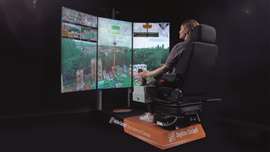 Radius Group’s new Skyline Cockpit system offers safety benefits as the operator controls the tower via screens from a cabin on the ground. (Photo: Radius Group)
Radius Group’s new Skyline Cockpit system offers safety benefits as the operator controls the tower via screens from a cabin on the ground. (Photo: Radius Group)
The company says the Skyline Cockpit system represents a seismic shift in crane operations, transforming traditional operator cabins into state-of-the-art computerised, ground control cockpits.
Through artificial intelligence (AI) and augmented reality (AR) software, as well as camera systems, Radius Group’s crane operators can manage and control tower cranes from the ground, which the company says will improve efficiency and safety on site. It can also offer financial savings.
Fewer accidents
Accidents and incidents are reduced as operators no longer need to climb up and down daily. Operators can instead work from the comfort and safety of an on-site ground cabin and navigate the tower crane using a three-screen interface.
The screens provide operators with an unobstructed view of the load line and the entire construction site. Radius says that offering a clear line of sight minimises the chances of collisions or accidents caused by limited visibility.
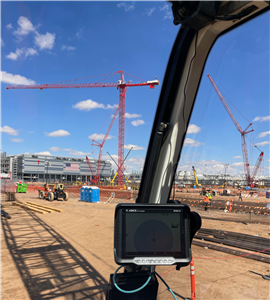 AMCS Technologies’ DCS 61-S crane safety system being used for for collision avoidance between tower and crawler cranes on a major project in Chandler, Arizona, USA. (Photo: AMCS)
AMCS Technologies’ DCS 61-S crane safety system being used for for collision avoidance between tower and crawler cranes on a major project in Chandler, Arizona, USA. (Photo: AMCS)
Operators also benefit from improved working positions, and the on-ground cabin is accessible for people with disabilities. By eliminating the need for operators to climb the crane, the system reduces downtime. Switching cranes on a multi-crane site can take just 10 to 15 minutes.
Automated data recording ensures productivity is measured accurately and labour calculated efficiently. Radius says this reduces risks, eliminates the need for rescue teams and simplifies safety procedures.
Machine learning
Using advanced algorithms and machine learning, the system offers analytics that can predict potential risks, provide recommendations for optimal lifting techniques and optimise crane performance based on historical data.
The system provides real-time data on critical factors such as load weight, wind speed and direction, crane height and work speed.
Skyline Cockpit’s AI and AR systems can detect tower crane discrepancies, enabling immediate preventive maintenance actions to minimise disruption to workflow, the company said.
Michael Fryer, Radius Group managing director, says, “We are very excited by the potential of Skyline Cockpit to truly revolutionise the construction industry and we are therefore extremely proud to be the first tower crane supplier in the UK to offer this pioneering innovation on live sites.”
Collision avoidance
In addition to the physical safety of workers, the crane industry is also dedicated to ensuring machinery is being used safely, particularly when there are several different systems at work on the same site. Collision avoidance technology is being continually developed and utilised.
For example, to help prevent collisions on site, AMCS Technologies was recently brought in to manage the interference between crawler cranes and tower cranes on a large and busy jobsite in the USA.
The French safety technology specialist said it is a world first that its DCS 61-S system is now managing interferences between tower and crawler cranes. It is a major high tech industry construction site in Arizona where multiple cranes of different types are working together, at the same time.
To avoid incidents of crane boom and rope clashes, especially in this example where there is an increase in the use of mobile machinery on site, the DCS 61-S can respond both to safety and work efficiency issues. The tech can adapt to the job site environment and help make decisions that promote safety and best working practise, the company says.
The site in question is the construction of two computer chip factories in Chandler, Arizona. AMCS Technologies is managing the interferences between 14 Manitowoc and Liebherr crawlers and three Potain tower cranes. The system automatically detects the movements of the crawler cranes and integrates it with the control of the tower cranes. Communication between the cranes is via a wireless network and the operators have a live update on each crane’s position via a GNSS antennae.
Real time data
When the crawler cranes move around the site to work, the tower cranes automatically know their positions and the system creates an interference zone. The DCS 61-S calculates in real time, and in 3D, the distances between each element of the cranes as well as the speeds of movement so it can intervene on the control mechanisms of the cranes, slowing the tower crane and then immobilising it at a pre-set distance from the mobile machine.
On the crawler crane, an increasingly loud sound signal is emitted as it approaches the prohibited area or interference zone.
“Through this new experience, we continue to do what we do best: make jobsite safer places to work and empower our customers with this major concern. It’s an inspiring win-win combination. It’s very exciting and provides so many opportunities for high-quality service,” Radoine Bouajaj, AMCS Technologies sales director, says about this project.
Anthony Lanza, Maxim Crane Works western regional tower operations manager, adds, “We can tell that we have had success preventing crane-to-crane contact from our crawlers to tower cranes. Once the systems were installed, this has been a great asset for us to use. Being able to have a safety net like this with the number of cranes onsite is definitely a benefit.”
AMCS Technologies and tower crane manufacturer and rental group Wolffkran announced an official partnership agreement at the ITC tower crane conference in June 2023.
This agreement will equip Wolffkran cranes with the DCS 61-S system. Wolffkran, headquartered in Switzerland, chose to integrate AMCS Technologies to its catalogue as an official supplier, to help guarantee construction site safety by managing interferences between static and dynamic obstacles.
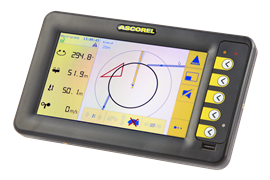 Ascorel will supply its tower crane collision avoidance technology systems to Wolffkran in Switzerland.
Ascorel will supply its tower crane collision avoidance technology systems to Wolffkran in Switzerland.
The system is compliant with European standards EN17076 and EN14439, and can be adapted for specific site requirements.
Technology specialists
Wolffkran also recently agreed a distribution deal with collision avoidance technology specialist Ascorel.
France-based Ascorel will supply its tower crane collision avoidance technology systems to Wolffkran Schweiz AG for use in the Swiss market. Wolffkran will be an agent for the supply and sale of Ascorel products. It will be able to use the systems on any of its own cranes or supply them as aftermarket kits for other makes of tower crane.
Ascorel has already been working with Wolffkran for several years and developed this system with the Wolffkran engineering department. This type of collaboration is seen across the industry as manufacturers and tech specialists alike work together to improve operations. After all, operating multiple cranes safely is complicated but it is also typical on a modern construction site.
DIGITAL MOVES
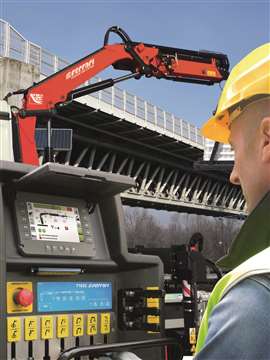 Fili Ferrari has equipped its cranes with an electronic platform to improve safety. (Photo: Fili Ferrari)
Fili Ferrari has equipped its cranes with an electronic platform to improve safety. (Photo: Fili Ferrari)
Italian hydraulic crane manufacturer Fili Ferrari has equipped its cranes with an electronic platform that complies with new European standards. The company says its platform promotes safety with the crane’s controls as it provides data and analytics. The company is developing systems for automatic levelling (ALS), automatic stabilizer activation (OAD), and verified crane lifting capacity based on truck stability (DLD).
The Lifting Equipment Engineers Association (LEEA) in thee UK has launched the LEEA Connect App (Version 2.0). The free to download app is available both to LEEA members and non-members. This means it can be downloaded by engineers, examiners and anyone with an interest in the safety or technical aspects of lifting operations.
Sure Grip Controls, a subsidiary of Bailey International, has acquired the Illinois, USA-based Industrial Electronic Controls (IEC). The acquisition of IEC will expand Sure Grip Control’s product portfolio and provide additional expertise in electronic throttles, displays and sensor manufacturing.
A1A Software launched a new website to serve as a portal to each of its products, including 3D Lift Plan, iCraneTrax, 3D Lift Vision, and the A1A Product Suite of app-based tools. In addition, A1A Software has recently moved to a new physical location in Florida, USA, which will provide more room for in-person training classes.
Germany-based CraniMax has updated its crane library and lifting planning app Craner. There are now more than 120 crane types available for jobsite investigations and crane type research.
STAY CONNECTED


Receive the information you need when you need it through our world-leading magazines, newsletters and daily briefings.
CONNECT WITH THE TEAM










